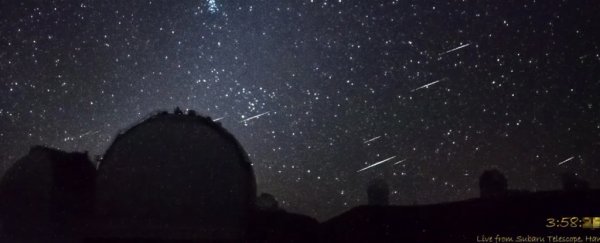In the small, pre-dawn hours of July 14, dozens of meteors blazed across the brilliantly clear starry skies above Maunakea, Hawai'i. The event was livestreamed to hundreds of people worldwide from the Subaru-Asahi's Sky Camera.
"At first I thought it was just a series of small meteors," explained livestream viewer Fukuro (night owl).
"But when I double-checked for a tally, I was amazed to notice that several small meteors were visible coming from the same direction at the same time."
At 3:58 am local time, these meteors all streamed from the same point in the sky within 10 seconds. This is not the normal pattern observed during meteorite showers, which usually appear more randomly in our skies when Earth sweeps through the orbit of comet tail remnants.

The excited online chatter about the phenomenon alerted Subaru Telescope camera administrator Ichi Tnaka, who contacted the astronomers now analyzing the data.
"The scientific significance of capturing such a rare phenomenon is extremely great, and it is especially significant because the overall duration of the event was longer than in previous cases," said planetary scientist Junichi Watanabe, vice-director of National Astronomical Observatory of Japan.
"The fact that the camera was located at Maunakea, one of the best observation sites in the world, was also a major factor in capturing such a rare event in addition to recent developments in camera technology."
Only a few such meteoroid clusters have been documented since the phenomenon was first identified in 1997, including one caught earlier this year by University of Arizona's camera systems in San Diego. That cluster of seven meteors occurred within 3 seconds of each other.
Watanabe described an explanatory mechanism for this sort of meteor clustering with colleagues back in 2003, based on evidence from Leonids meteor storms.
The researchers calculated that for these bits of space rock to swarm into our skies so close together in timing and distance, they would have to have an unrealistically small difference in velocity between them - if they'd fractured directly or soon after breaking off from a comet.
Instead, they concluded, this type of clustering is most likely explained by the fragmentation of Sun-orbiting meteoroids just before they reach Earth. Meteoroid fracturing is likely caused by the extra heat they encounter when reaching the perihelion of their orbit (closest point to the Sun), which should occur around every 33 years for the Leonid meteoroids.
The information just captured by the Subaru telescope may help clarify this, and possibly provide more structural information about the meteoroids orbiting near us.
